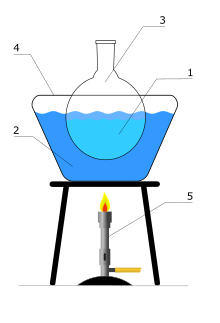Heated bath
Appearance

A heated bath is used in the laboratory to allow a chemical reaction to occur at an elevated temperature.
The heated bath is a fluid placed in an open (metal) pot. Water and silicone oil are the most commonly used fluids. A water bath is used for temperatures up to 100 °C. An oil bath is employed for temperatures over 100 °C.
The heated bath is heated on a hot plate, or with a bunsen burner. The reaction chamber (florence flask, erlenmeyer flask, beaker) is immersed in the heated bath. A thermometer is usually kept in the fluid to monitor the temperature.
